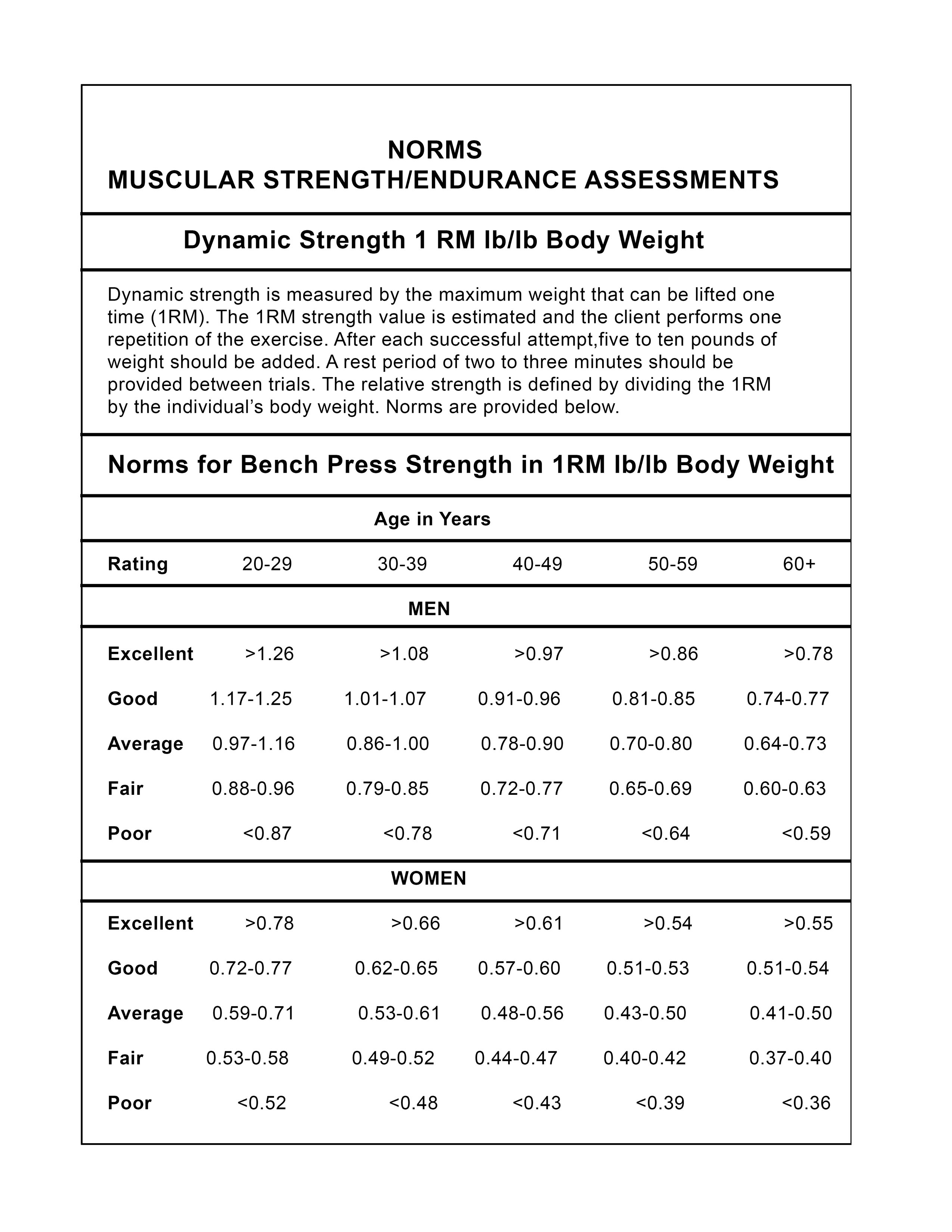A frequently performed 1 RM measurement is the bench press test, which assesses the strength of the pectoralis major, anterior deltoid, and triceps muscle groups. The maximum amount of strength for one repetition is found through trial and error.
Source for bench press test:
ACSM's Health-Related Physical Fitness Assessment
The procedure follows for the 1 RM bench press:
1. Warm up by rhythmically limbering and statically stretching the muscle groups to be tested.
2. Familiarize the client with the equipment and start with a weight that can be comfortably be lifted. Then progressively add weight until the weight can be lifted with proper form just one time (try to find the maximum amount within the first three attempts to avoid excessive fatigue). Allow yourself time to rest three to five minutes between trials.
3. After finding the 1 RM for the bench press, divide the 1 RM weight (in pounds) by the client’s body weight (pounds) in order to apply the norms.
Download Bench Press Test Norms Chart (17" by 11")
Researchers have found that the 1 RM Bench Press (as well as the 1 RM Military Press), is the most valid measure of upper body strength. (Norms also exist for the 1 RM Leg Press, which test the muscle strength of the upper leg muscles.) The test is relatively safe (especially when performed on a bench press machine), the subject’s back is supported, the equipment is readily available in most fitness facilities, and the test is easy to administer.
Disadvantages include the potential for injury that exists with any maximal effort, the fact that you may perform the Valsalva maneuver, the lack of portability of the equipment, and the “intimidation factor” for you if you are unfamiliar with weights. In addition, some research indicates that the 1RM test is not appropriate for beginners.
To minimize a few of these disadvantages, some experts recommend measuring a percentage of the client’s 1RM. For example, if your client can perform six but not seven repetitions of a bench press at 80 pounds, then he/she has a 6 RM of 80 pounds.
Record your results.
|
Bench Press lbs._____________________Trail 1 Bench Press lbs._____________________Trail 2 Bench Press lbs._____________________Trail 3 Maximum lift / Body Wt. (lbs) x 100 =____________% of Body Wt. lifted |
Bench Press Norms
|
|
Below Average |
Average |
Above Average |
Outstanding |
|
Women |
40% or below |
40-50% |
51-60% |
61% or above |
|
Men |
86% or below |
87-96% |
97-112% |
113% or above |
What should your one max be according to your weight and gender?
According to the ACSM your one max rep percentage is determined by your age and weight.
Generally it is considered good to be able to bench press your body weight at least 1.1 times your body weight for men. (This is considered intermediate). For women, you are considered strong if you can lift .77 times your body weight for one repetition. The chart to the left breaks down different levels of the one rep max.
It is also good to be able to calculate your max percentage when creating a workout routine. Below is a quick reference chart of max weight percentage. First locate your max bench press weight in the left column. Then find the percentage that you want to workout at on the top column. For example, if you want to perform a chest workout using 75% of your max and your max is 225. Simply find 225 in the left column and slide over to the 75% and that will give you a weight estimate of what you should workout at. Below is a quick reference chart for weight percentages.
How much should you lift according to your age?
You can find out how what percentile your bench press is according to your age group. First you must determine your max bench press. After that, divide your weight by your max bench press to determine the lift to bodyweight ratio. Find your ratio on the chart according to your age to see what percentile you fall under.
If you want to learn more details about performing fitness assessments check out...


